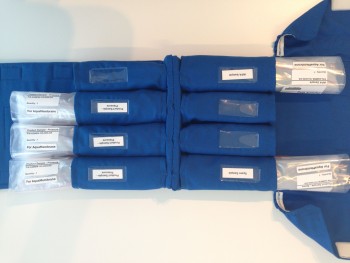Flight day 4, Saturday, is an important day for the Aquamembrane experiment that will see if a new type of membrane that filters water without energy is suitable for use in space.
Andreas will take three bags of waste water from the International Space Station and set each of them to be processed by a dedicated membrane that works by mimicking the cells in all living beings. Only two bags will be processed today.
Andreas will set up three Aquaporin Inside membrane assemblies and set 100 ml aside as a control. Once set up, he will flush the membrane modules five times to ensure proper circulation. After that he will just wait as the water flows from one side of the membrane to the other leaving unwanted organic molecules behind.
In between the flushing sessions Andreas will have a number of adaptation periods, emergency training drills with his crewmates and be shown around the Station that is the size of a six-bedroom villa.
After lunch Andreas will record some of the video messages from the Cupola observatory for educational purposes and will also prepare for a live talk with the Prime Minister of Denmark, Lars Løkke Rasmussen, all the while frequently returning to the Aquamembrane experiment to flush the membrane modules when necessary.
A first tasting session is planned for the DEMES experiment where Andreas will test his taste buds in space. In a connected experiment Andreas will take pictures of samples of stored organisms that might be used in the MELiSSA recycling loop to tune the production of food, water and oxygen and the processing of wastes. The scientists on Earth want to have an image of the organisms to chart their progress.
Lastly, as usual Andreas will fill in his Space Headache questionnaire but this time he will use a computer instead of the pen and paper he used in the Soyuz spacecraft over the last three days. He will take pictures of the three questionnaire papers from the flight to the Space Station and send the images down to Earth for the researchers running the experiment.




Discussion: 4 comments
Small correction:
As Denmark is a monarchy, we do not have a President. Hence Andreas’s live talk on Day 4 will be with Prime Minister Lars L. Rasmussen 🙂
Thank you! I actually knew that, but it was a long day for me as well…
In the paragraph before the last one, the text ends with “to chart their”….
What is meant here?
Many mistakes in this entry. The sentence was missing the last word. The team want a photo of their experiment to monitor it.